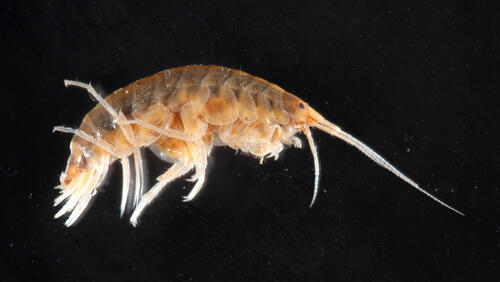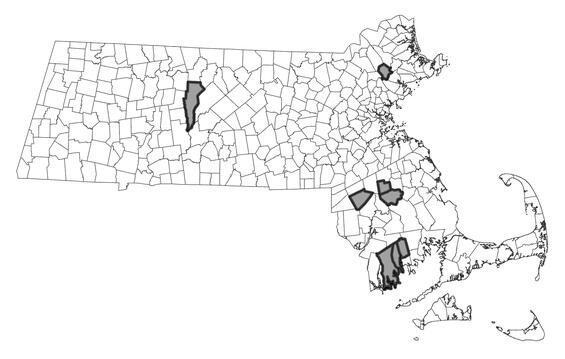- Scientific name: Sicifera chamberlaini
- Species of Greatest Conservation Need (MA State Wildlife Action Plan)
- Special Concern (MA Endangered Species Act)
Description

Coastal swamp amphipod
The coastal swamp amphipod is a laterally compressed, many-segmented, freshwater crustacean that looks like a small, flat shrimp. The species is orange in color with a green tinge. Mature females range in length from 8.0-11.5 mm (0.31-0.45 in) and males from 4.8-8.5 mm (0.19-0.33 in; Smith 1987). Its head has two pairs of antennae and a pair of eyes and is fused with the first of seven thoracic segments. Each thoracic segment, as well as the six abdominal segments, has a pair of legs and/or gills that aid in respiration and locomotion.
All amphipods are quite similar in appearance. Positive identification is difficult without knowledge of the morphological characteristics of amphipods. Identification guides sufficiently illustrate the differences among the species found in southern New England (Smith 2000). The coastal swamp amphipod is often found with other amphipods including Crangonyx, Hyalella, and Gammarus species.
Life cycle and behavior
The coastal swamp amphipod has an annual life cycle. In winter and spring, reproductive females brood up to 65 eggs per clutch (Holsinger 1972). Adults are found from mid-spring to early summer and disappear by late June (mid-July in Rhode Island). Juveniles are found in late summer and fall (D.G. Smith, personal communication 2003). Aggregations of adults and juveniles have also been observed during winter months.
In general, amphipods aggregate in large numbers and remain hidden in organic debris or among beds of aquatic vegetation. All appendages are used to aid locomotion, and some specifically aid in swimming by providing a thrusting force, while others flex outward to bend the body, allowing for a side-swimming movement. It is for this reason that amphipods are given the name “sideswimmers” or scuds (Smith 2001). Amphipods react negatively to light and so tend to be more active at night.
Distribution and abundance
The coastal swamp amphipod range extends south from South Carolina along the Atlantic Coastal Plain (Holsinger 1972), into southeastern Maine. In Massachusetts, the species occupies coastal watersheds along Buzzards Bay, Taunton River, Ipswich River, and Millers River watersheds. Relatively recent observations have expanded its known range beyond the southeast and into northeast and central Massachusetts watersheds. Despite this, the status of the coastal swamp amphipod populations in Massachusetts remains uncertain. This species is rarely encountered here and is listed under the Massachusetts Endangered Species Act as a species of special concern. All listed species are protected from killing, collecting, possessing, or sale, and from activities that would destroy habitat and thus directly or indirectly cause mortality or disrupt critical behaviors. In addition, listed animals are specifically protected from activities that disrupt nesting, breeding, feeding, or migration.

Distribution in Massachusetts
1999-2024
Based on records in the Natural Heriage Database.
Habitat
In Massachusetts, the coastal swamp amphipod is found in heavily vegetated, low-gradient, acidic wetlands (wooded and shrub swamps, marshes) and associated streams including red maple and white cedar swamps in the Buzzards Bay moraine deposits (Smith 1987). This species can also be found in emergent marshes adjacent to these outlet streams. Elsewhere, the coastal swamp amphipod is known from small streams, bogs, ponds, and ditches (Holsinger 1972).
Healthy habitats are vital for supporting native wildlife and plants. Explore habitats and learn about conservation and restoration in Massachusetts.
Threats
Threats to this species include habitat degradation including draining, filling, or destruction of wetland swamps, chemical pollutants from road and impervious surface runoff, nonnative riparian or aquatic plant species, and streamflow alterations.
Conservation
Survey and monitoring
Surveys for coastal swamp amphipod are needed at historical sites in the southeastern part of the state. Additionally, with the discovery of the species in new major watersheds, effort should be reserved to survey potentially suitable wetlands not yet sampled particularly in the northeast and central watersheds of Massachusetts. Monitoring efforts are recommended at least every 5-10 years or as needed (e.g., in response to potential disturbance or stressor events) at the species’ most high-quality sites.
Management
Protection of riparian areas and associated uplands should be a priority to maintain water quality and quantity. Prevention and control of invasive riparian plant species may also be warranted to preserve leaf litter composition and quality for species consumption. Alternatives to commonly applied road salts should be tested to minimize freshwater salinization.
Research needs
Surveys should continue to target historical but also identify new wetland streams to better understand their distribution, relative abundance, and habitat requirements in Massachusetts. Physical surveys coupled with eDNA collections could improve species detection, assuming species DNA markers are developed.
References
Holsinger, J.R. 1972. The freshwater amphipod crustaceans (Gammaridae) of North America. United States Environmental Protection Agency. Biota of Freshwater Ecosystems. Identification Manual 5: 1-89.
Smith, D.G. 2001. Pennak’s Freshwater Invertebrates of the United States: Porifera to Crustacea. Fourth Edition. Wiley and Sons, Inc. NY. 638 pp.
Smith, D.G. 2000. Keys to the freshwater macroinvertebrates of southern New England. Published by author. Sunderland, MA. 243 pp.
Smith, D.G. 1987. The genus Synurella in New England (Amphipoda, Crangonyctidae). Crustaceana 53 (3): 304-306.
Contact
| Date published: | March 12, 2025 |
|---|